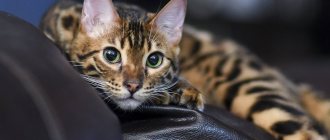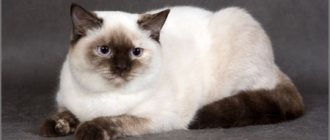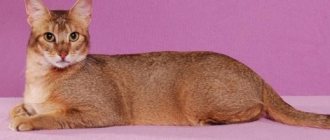Origin story
The official date of appearance of Cornish Rex cats is 1950, although funny curly-haired kittens were met much earlier.
For example, in the 30s, Berlin, under the walls of a local hospital, or at a fair in England in the 40s. But people, clucking their tongues in surprise, quickly forgot about them. For now, as it turned out. Nina Ennismore, a Cornish farmer, often looked at her feet rather than around her. That is why she discovered a tiny floppy-eared creature in the bushes along the road, which, as she first thought, was clearly unhealthy.
A compassionate woman brought the exhausted, half-dead baby home, washed it and fed it. Little Kalibunker, having fallen into caring hands, began to grow and mature to the delight of his savior. With age came problems: Kalibunker demanded a cat and carnal pleasures so persistently that he did not let him sleep at night, and the owner decided to take the restless cat to a veterinarian she knew for castration.
He immediately realized that the curly fur and huge ears were not just external flaws, but a real calling card of a new, hitherto unknown breed, and advised Ennismore to show the animal to breeders Jude and Stirling. The woman left them inspired: the breed had been confirmed. It was possible to start breeding.
At first, Kalibunker was matched with an ordinary outbred cat: this was a test for the stability of the mutation. Two out of three kittens were born with the same external characteristics as Kalibunker. Subsequent experiments showed that the type of inheritance in this case is recessive, i.e. curls appear more often if both parents are carriers. They began to bring the cat together with his own mother.
Due to a number of problems, by 1960, only one Cornish Rex survived, named Sham Payne Charlie, who later became the founder of the breed branch.
By 1983, the breed was officially recognized by all major world felinological organizations, and several individuals were transported to the USA.
The Cornish Rex cat got its name from the place where it was born - Cornwall. The second part - rex - indicates wavy fur.
Funny kittens
Little kittens always bring a smile and affection. Such Cornish Rex kittens can be purchased in nurseries, where breeders are responsible for the health and purity of the breed. And who is closer to your liking - decide for yourself:
- White curly fur, pink nose and the same pads on the paws, blue or golden eyes.
- Blue kitten - the farther from the nose, the bluer. Only the eyes are golden and the nose is gray. And no options.
- It doesn’t get any blacker—the nose, tail, paw pads—blacker than the blackest night. And – golden eyes.
- The nose is creamy - no, rather pink, the paws are soft pink, and the fur has a pinkish tint.
- Red - bright, thick and shiny - golden fleece - fiery sparks in the eyes, on the pads of the paws, on the nose.
Ideal character, ideal pedigree - a miracle cat with strange eyes. It’s impossible not to fall in love!
Standards
Refined grace is what comes to mind when looking at Cornish Rex cats. However, do not think that these creatures are fragile and pampered. Beneath the velvet coat are strong muscles and a strong bone structure. Cats weigh a little: females - 3-4 kg, males - no more than 5.
There are 2 types of standards: American and English. There are many similarities, but there are also differences. Moreover, the judges of both FIFe and WCF give preference to the first description.
| Standard | Description |
| Head | Egg-shaped (in the American species) or triangular (in the English species). The forehead is convex, rounded, the cheekbones are high and clearly defined. The chin is strong, the neck is strong, but thin. The jaws are powerful, the bite is correct (but a slight undershot is not considered a defect). |
| Ears | Very large, stand upright, rounded at the ends. Set wide apart. |
| Eyes | Oval, slanted, the iris is brightly colored, any color is allowed. |
| Torso | Elongated, strong, tucked belly, arched back, strong chest, there is a hint of a waist. The limbs are thin, which creates a clear contrast with the body. Paws are oval, fingers are long. |
| Tail | Long, tapering towards the tip, very mobile and flexible. |
| Wool | Very soft, feels like delicate silk. It fits tightly to the body (despite the complete absence of guard hairs) and lies in uniform waves. Curly hair is most severe in the abdomen, chest and chin. |
Significant disadvantages:
- Small ears.
- Wide or too long head.
- Massive stocky body.
- Bald patches on the body.
- Bald, shaggy or short tail.
An animal is removed from the competition if it is found to have:
- Deafness.
- Lameness.
- Undescended testicles.
- No claws.
- Tail with kinks or loops.
- Coat that is rough to the touch.
- Extra fingers.
Like all purebred cats, Cornish Rex cats are divided into 3 groups. Depending on which group the animal belongs to, its cost is determined.
Pet class kittens cost from 10 to 20 thousand rubles, breed class kittens (intended for breeding) - from 25 to 40 thousand rubles. The most expensive - show class kittens that successfully participate in various kinds of exhibition events - are more expensive than the rest (the price starts from 40 thousand).
Character and behavior
Miniature Cornish Rex, being human, would be considered real intellectuals. However, while remaining animals, these creatures are distinguished by their sharp mind, quick wit, and ability to analyze and draw conclusions from the situation. These life-loving kids seem to have a motor hidden inside them: both children, teenagers, and adults who are wise in life are active, mobile and playful. They love to jump, climb, jump from place to place, roll balls and spools of thread, playfully hunt for their owner's legs and play with water and plants in pots.
They are not vindictive, but they are easy to offend: if you hit a cat in a fit of anger, it will remember it for a long time and will shy away from your hands. When teaching an animal commands, hide your aggression away, and if the animal is very guilty, you can slap the newspaper on the table or floor next to it, but not on the cat itself.
Cornish Rex, once in the house, immediately choose a leader, to whom they experience boundless tenderness and devotion. They do not shy away from others, they show friendliness and kindness towards them, but they will only look into their eyes and wag their tail, like a dog, with their beloved owner.
They are loyal to strangers, but do not tolerate familiarity. Children are treated with care, and during games they are careful not to harm the baby. They do not extend their claws, do not hiss and do not show aggression, even if a child hurts the cat or starts teasing it, but at the first opportunity they will run away and hide. In general, they are quite patient.
They get along easily with other cats and dogs, but if they think that you are paying more attention to the other pet, they will be very jealous and try to challenge their opponent to a fight.
If you plan to move two cats into one apartment, one of them should be neutered in order to avoid endless showdowns, dividing up territory and marking corners. They behave like hunters with birds and rodents.
The commands “sit”, “lie down”, “voice”, “carry” are learned quickly. They love walks, so from childhood accustom your cat to a harness and leash. During the cold season, dress your cat in a warm suit to prevent her from catching a cold.
They can't stand being alone, and they especially don't like closed doors. They will meow heart-rendingly and scratch at the locked door until they become hoarse.
Until 1982, new blood was actively “infused” into the breed, but the reason was banal: breeders were afraid of losing animals due to inbreeding. And the threat of serious genetic failures and pathologies hung like a sword of Damocles. However, later, when all the necessary traits and characteristics were fixed, and several dozen lines of Cornish Rex were obtained, the need for “fresh blood” disappeared.
Character of the Cornish Rex
Cornish is an inexhaustible source of energy, preferring racing for a ball to relaxing on a soft sofa. Cats use any discovered objects as toys, so it is better to hide valuables in an inaccessible place. Make sure you have enough interactive toys to direct your pet's activity in the right direction.
Before buying a Cornish at home, you will have to install an “anti-cat” - a special net that protects against falling from the window. Curly-haired cats love to explore the territory, so not a single flying pigeon escapes them. This sense of adventure can be dangerous without reliable window insurance.
The character of the Cornish Rex is very loyal, so the animals diligently surround their owners with their attention. Tactile signs of attention are always accompanied by sound signals that have a wide range. If you get a Cornish dog, you will soon learn to understand the meaning of the sounds it makes.
Cats treat strangers with caution, allowing close contact only after careful examination from the outside. Animals get along well with children, but do not tolerate excessive importunity. The child will not suffer from their paws, but the Cornish may receive psychological trauma from careless handling. When communicating with other animals, cats can show jealousy, and perceive rodents and birds only as prey.
Tailed pets love to sit on their hands, as they are constantly cold. Due to the small amount of fur, their body temperature appears to be higher than that of other cats, but this is a false impression. If you prefer to walk animals, then keep in mind that it is dangerous for Cornish cats to be outside in winter.
The breed is not suitable for workaholics, and even an ordinary five-day period causes an acute feeling of loneliness in cats. Cornish cats quickly become attached to their owners and are especially affectionate towards the female half of the family. The most affectionate characters are those cats that love to perch not only on the arms, but also on the shoulders of the owner.
Care instructions
Cornish Rexes require special care. It cannot be called complex, but there are some nuances.
Bathing
Firstly, these cats need to be bathed more often: not once every six months, like Siamese, for example, but weekly. After all, their guard hair is not thick and this leads to the fact that sebum is not absorbed, but remains on the surface, giving the cat an unkempt appearance. Rexes cannot properly lick themselves, so teach your animal that a weekly bath is a must. Give your cat a separate towel and shampoo (not human shampoo from a nearby stall, but a special one from a pet store). After bathing, the cat is dried and dried with a hairdryer.
Does your cat like to swim?
Not really
Shedding
Molting is not about them. You shouldn’t buy expensive combs either, but a simple piece of suede will help remove dead hairs from your body.
Claws
The Cornish Rex's claws are not completely hidden (the paws are too small), so install one or more scratching posts at home and trim the tips of the claws with nail scissors (nail clipper) every week. Try not to damage the vessels inside!
Eyes
It happens that cats’ eyes begin to “leak.” Strong tea leaves, chlorhexidine or plain boiled water will help remove dark marks and give the cat a more tidy appearance. Soak a cotton swab in the liquid and carefully remove dirt. This discharge does not pose any health hazard, but when it dries, it forms a dense crust that the cat can tear off with its paw. And with it - and tear out the hair under the eye.
Teeth
Cats' teeth are brushed once a month, using gentle sweeping movements from the gum to the tip of the tooth. Human paste is not suitable - it is poisonous to animals. Buy a special paste at a pet store.
The photo shows the Cornish Rex breed at different ages
Historical reference
Country of origin: England. The history of the Cornish Rex began in 1950, when a yellowish-white cat with an unusual wavy coat appeared in Cornwall. The animal was shown to geneticist Jad A.S., who revealed the presence of a mutant Rex gene. Subsequently, the cat was bred to his tortoiseshell mother, and kittens with wavy fur appeared in the litters. The breed was named "Cornish Rex", the word "Cornish" indicating the place of origin (Cornwall), and the word "Rex" indicating the wavy coat gene.
Since the population of these animals was very small, they were crossed with American, Siamese, and Havanese cats. However, today matings with other breeds are not allowed in order to preserve distinctive features. The Cornish received official recognition in 1967. In 1983, 3 main branches were identified - Cornish, Devonian, Germanic, and changes were made to the standards.
The breed first appeared in Russia in 1989; animals were brought to the exhibition of the FPC “Sirius” from Sweden and Finland. A year later, the first nursery called “Santa Berger” was created in the country. Every year the number of Cornish Rex cats in Russia is increasing more and more, and the number of fans of the breed is also growing.
Catering
Cornish Rexes are prone to overeating and rapid weight gain, so your task is to structure the diet in such a way that your pet gets enough nutrients, but does not turn into a curly bun.
Basic Rules:
- Teach your animal to eat at the same time: early in the morning and in the evening. Remains of porridge and other perishable foods should be thrown away immediately, and the bowl should be washed thoroughly (but only without using chemical cleaners). Dry food can last longer.
- When choosing natural food, do not imagine that if your cat begins to feast exclusively on meat and fish, he will become stronger and healthier. Quite the opposite: excess protein will “impair” both the liver and kidneys, and excess fish will lead to urolithiasis. Meat should be alternated with cereals, vegetables, and dairy products.
- You can only drink water: clean, comfortable temperature (neither cold nor hot). Tap water is suitable, but it must first be left to stand for 10-12 hours. Giving your cat tea, juices, alcohol and other human drinks is prohibited. Be careful with milk: it gives many cats an upset stomach.
Natural products
Natural food includes:
- Lean meat (beef, veal, rabbit, lamb and turkey);
- By-products (chicken necks, liver, kidneys, hearts, ventricles, cartilage);
- Fish (flounder, salmon, trout, navaga, hake);
- Porridge (rice, buckwheat, oatmeal, millet);
- Vegetables (zucchini, asparagus, broccoli, cauliflower, carrots, pumpkin);
- Boiled chicken yolk, quail eggs;
- Dairy products (kefir, fermented baked milk, low-fat cottage cheese, natural yogurt, sour cream, yogurt).
Raw meat can be infected with parasites, so before serving, it is frozen and then scalded with boiling water, stewed or boiled. The same applies to offal and fish. Vegetables can be given either raw or boiled.
The following cannot be included in the menu:
- Salty, sweet, smoked, fatty, sour, canned, pickled;
- Pork, lard, tripe, bones (even small ones);
- Human canned food and vitamins, dog food;
- Potatoes, tomatoes, onions, garlic, eggplants, fruits (exception: apples, melons and watermelons), legumes, cabbage, nuts, mushrooms.
- Dried fruits;
- Condiments, spices, sauces, mayonnaise, ketchup.
Recommended food
Breeders recommend feeding your Cornish Rex natural food, but if you choose ready-made industrial food, buy a holistic product: Acana, Pronature Holistic, Savarra.
Below are the recommended holistic and super-premium foods. Links with the names of the food are clickable, on them you can, within our website, get acquainted with the descriptions of the food and read reviews from owners of Cornish Rex cats.
| Super premium | Holistic | Holistic |
| Matisse | Grandorf | Nutram |
Care and maintenance
Cornish Rex individuals are very thermophilic. They prefer to rest in cool places. Therefore, they should be provided with a warm and cozy place to sleep and relax.
Some representatives of the breed are quite active and will be happy with the play complex. The Cornish Rex must have its own “corner”.
Also, before purchasing a kitten, you should take care of the following in the house:
- Cat litter box;
- Hygiene products;
- 3 bowls (2 for food, 1 for water);
- Toys and carriers;
- Medicines, high-quality filler and special food (breeders will help with the choice).
You will definitely need a carrier for further walking of the animal. When transporting your pet outside, be sure to provide him with warm clothing.
Diseases
The Cornish Rex does not have any specific diseases unique to this breed. But their health still cannot be called strong. There are several reasons for this.
Firstly, Cornish Rex are very sensitive to climate changes and temperature changes. Even a small draft can easily cause a cold (an elongated tear duct also provokes this), so make sure that the cat does not sleep near open windows, and after bathing, dry it thoroughly with a towel and dry it with a hairdryer or near a heater.
Secondly, a weak stomach and sensitive liver require a special diet. Improper metabolism also plays a role. Cats should not be fed cheap food or overfed.
Thirdly, the sebaceous glands located at the base of the tail often provoke a disease called “sebaceous tail”. Already from the name it is clear what the matter is: the sebaceous glands produce too much fat, it accumulates in a bad-smelling mass in the tail area, the skin turns red, becomes wet and becomes covered with pustules, scabs and eczema. Treatment consists of observing hygiene rules and treating with special products (Safroderm, Tsamax, chamomile decoction).
- Retinal atrophy is of two types: early (dysplasia), which is found in small kittens, and late (progressive). It is not a genetic disease in this breed, but is diagnosed quite often. Spreads to both eyes, the cat goes blind in 1-2 years. There is currently no treatment.
- Hypokalemia is a lack of potassium in the blood. Causes: kidney pathologies, anorexia, aldosteronism (primary). The cat experiences muscle weakness, lethargy, pain, and sometimes breathing problems. Treatment is medication.
- Alopecia is baldness, partial or complete. This also includes follicular dysplasia (a disease in which baldness causes a disruption in the production of melanin). The reasons are varied: hormonal imbalance, stress, constant licking of the skin (for example, if a cat has a tumor in its stomach and is suffering from pain), trauma, overheating. In some cases, it occurs in artificial kittens. It is treated with medication, and sometimes it goes away on its own over time.
- Ringworm is a fungal infection in which gray scales appear on the animal's paws and head. It is treated with medication, like candidiasis of the mucous membranes.
Cornish Rex cats often suffer from food allergies; the disease is usually diagnosed at the age of 4-5 years. Allergens should be excluded (usually eggs, pork, many types of fish).
Expert opinion
Dusheba Vera Ivanovna
In 2010, she graduated from the Moscow State Academy of Veterinary Medicine named after K.I. Scriabin with honors, specializing in veterinary medicine. I regularly attend veterinary conferences, congresses, and webinars.
Do not forget about preventive vaccinations and deworming - these procedures protect the animal from serious diseases!
What planet are you weird cats from?
They are, indeed, often considered aliens. In some ways they resemble sphinxes - the Cornish Rex has large, simply huge ears combined with a small wedge-shaped muzzle, on which cheekbones, a straight nose, and an unusual curly mustache stand out.
Add to this almond-shaped eyes of green, yellow or greenish with a golden tint, and you get the breed standard.
If you add to this a long torso with a noticeable curved arch of the back, a long flexible tail and equal width shoulders, chest and hips, then your cat has the right to claim the highest titles and awards at exhibitions.











